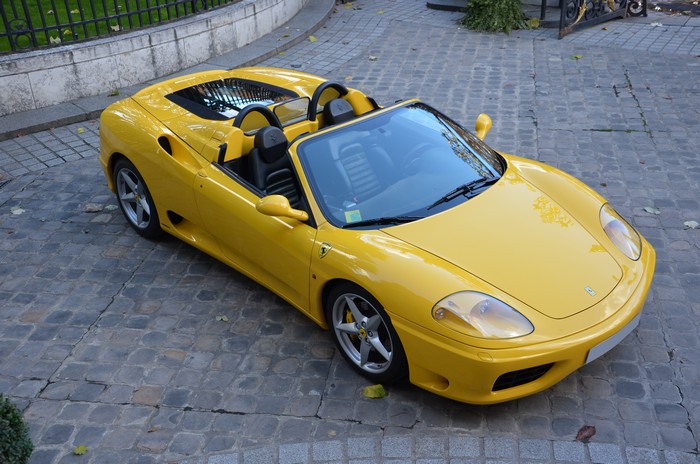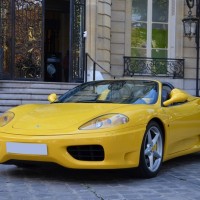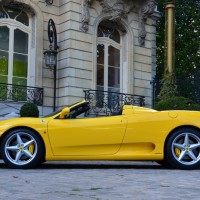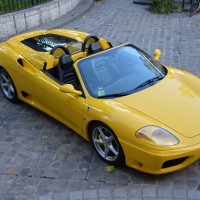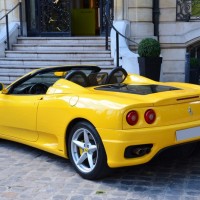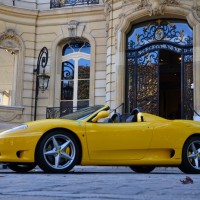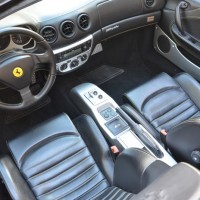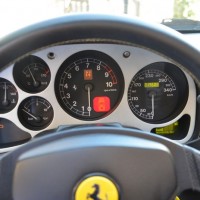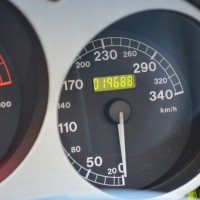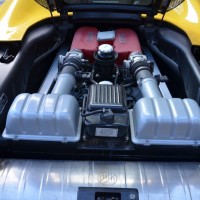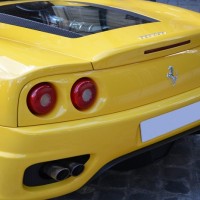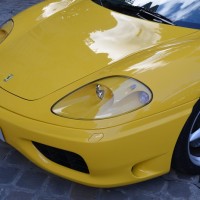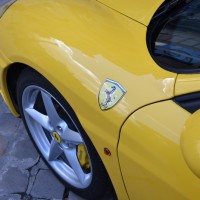Maranello Motors in England delivered this superb cabriolet to its first owner, an emir of Riyadh in Saudi Arabia. It formed part of a large fleet of vehicles and was rarely used. In 2008, a French industrial company specializing in steel production bought the car, which was kept for special occasions as part of an impressive collection. It is this company that has asked us to sell the car. It has just been inspected by Ferrari — Charles Pozzi in Levallois-Perret, who found no faults. It has covered 19,800 km (12,303 miles) and the bodywork is impeccable, with a flawless black leather interior and as-new carpets.
It appears to be in excellent mechanical condition, starting on the first turn of the key. It has an outstanding steering wheel-controlled sequential gearbox, which is wonderful to use. The black hood is electrically operated and in perfect condition. Here is an exceptional car that is as easy to drive as a Golf, very well balanced and precise, with an exhilarating engine note. A fantastic opportunity at a very reasonable price!
SCM Analysis
Detailing
| Vehicle: | 2004 Ferrari 360 Modena Spider F1 |
| Number Produced: | 7,565 Spiders, 8,800 coupes |
| Original List Price: | $186,950 |
| Tune Up Cost: | $2,800 |
| Club Info: | Ferrari Club of America |
| Website: | http://www.FerrariClubofAmerica.org |
| Alternatives: | 2006 Lamborghini Gallardo Spyder, 2004 Aston Martin DB9 Volante, 2004 Mercedes-Benz SL500, 2004 Porsche 911 Cabriolet, 2004 Dodge Viper |
This car, Lot 118 sold for $87,714, including buyer’s premium, at the Artcurial Paris auction on November 11, 2012.
“A Ferrari is a 12-cylinder car.” This quote is often attributed to Enzo Ferrari, although he probably never said it in earnest.
While Mr. Ferrari thought that the 12-cylinder engine was the perfect powerplant, he raced 4-, 6-, 8-, 10- and 12-cylinder cars. Even Phil Hill’s Formula 1 World Championship was in a 6-cylinder car. Clearly, Mr. Ferrari was open to using whatever engine configuration did the job best.
In 1967, Ferrari introduced the 206 Dino. The Dino was Ferrari’s first production mid-engine car and the first production car powered with something other than a 12-cylinder engine. The Dino was a sports car — rather than one of Ferrari’s traditional grand touring cars. It was an immediate hit and spawned a line of mid-engine sports cars that have been Ferrari’s best sellers for the past 45 years.
The introduction of the 206 Dino also started the debate: Is a non-12-cylinder car truly a Ferrari? The debate has continued through the 246 Dino, the 308, the 348 series and up to the arrival of the F355.
A new supercar
The F355 was the game changer. Autocar magazine stated that with the introduction of the F355, Ferrari “has created a new Supercar class,” and they were certainly right. The F355 design team borrowed liberally from Ferrari’s racing department to develop a car that was the most sophisticated Ferrari production car built up to that time. The car was a giant leap from the F355’s predecessors and left all of Ferrari’s competitors wondering what hit them.
The F355 was powered with a 3.5-liter, 375-hp V8 that featured an innovative five-valve-per-cylinder head. The F355 was Ferrari’s first mid-engine production car to use a 6-speed gearbox, and it was the first production Ferrari to be offered with a F1- style paddle-shift gearbox.
Additionally, the F355 design went through extensive wind-tunnel testing, resulting in an underside that was so aerodynamically advanced that pictures of the bottom of the car were a highlight of the F355’s promotional material. The F355 rocketed to 60 mph in less than five seconds on the way to an incredible 183 mph top speed. The debate was over: Anyone denying the F355 true Ferrari status must also believe the Earth is flat.
An even better car
As good as the F355 was, there was room for improvement, and the 360 Modena did the job. Instead of warming over the F355, Ferrari’s designers started with a clean slate and developed a totally new car. For starters, Ferrari partnered with Alcoa to develop a stronger, lighter aluminum frame to replace the F355’s steel chassis. The new frame was then dressed with a beautiful Pininfarina-designed body — also made of aluminum. The pop-up headlights and flat surfaces of the previous 3 Series Ferraris were replaced with the 360’s continuously flowing curves — which were reminiscent of the beautiful Dinos.
Inside the body shell, the 360 was all new as well. The interior was larger, with more comfortable seats. The front trunk was larger, too. In back, the old 3.5-liter engine got bumped to 3.6 liters, with the horsepower moved up to an impressive 390. The F355 F1 gearbox was more of a novelty than a precision tool, but improvements in the 360 made it a serious option. The shifts were faster, the clutch actuation much smoother and the automatic mode reasonably simulated an automatic transmission.
Driving an F1-equipped car in the manual mode is not the mind-numbing exercise that manual shift proponents claim. Yes, it’s as simple as flicking the paddles, but let your mind wander, and you’ll quickly end up in the wrong gear. Mastering an F1 transmission takes coordination and concentration. It is quite rewarding when done perfectly. In automatic mode, the F1 is not the equal of a normal automatic, but flogging an F1-equipped 360 in manual mode around a track is a special treat.
On the road, the 360 is a real barn burner. The 0–60 mph time is in the low four-second range. Top speed exceeds 180 mph. On the track, the formidable F355 is reduced to a distant second. If the F355 proved that a V8 Ferrari could be a worthy of the name, the 360 Modena added an exclamation point.
Belt services not a problem
One of the main obstacles to Ferrari ownership has been maintenance cost. V8 Ferraris have rubber timing belts that have to be replaced at regular intervals. The belt change — along with valve adjustments and other procedures — can push V8 major-service cost over the $5,000 threshold.
Ferrari acknowledged the problem and switched to hydraulic lifters on the F355, eliminating the need to adjust valves. On the 360 Modena they addressed the timing-belt replacement cost by adding an access panel in the bulkhead, so the belts can be changed without removing the engine. Finally, with the F430, Ferrari switched from timing belts to timing chains, and maintenance is now limited to little more than fluid changes.
A driver — and not yet a collectible
Ferrari has gotten aggressive about selling options, with the average new car having over $40,000 in toys. Artcurial’s 360 was a Spider version with a soft top that is hidden under a hard shell when the top is down. Artcurial didn’t list the options on their car, but the F1 transmission, painted calipers, and the obligatory Scuderia badges are apparent. The car showed the equivalent of a little more than 12,000 miles, indicating the owners liked the car and often picked it over the other cars in their fleet.
The 360 market is nothing like the vintage Ferrari market. There are lots of 360s available, and buyers have no problem finding one or determining how much to pay for one.
Sellers have a lot of competition, and they have to be competitive if they want to sell their car. There’s no drama with this sale. The car sold right on the mark, with the seller getting a fair price and the buyer getting a fair value. Call this one a draw. ?
(Introductory description courtesy of Artcurial.)
